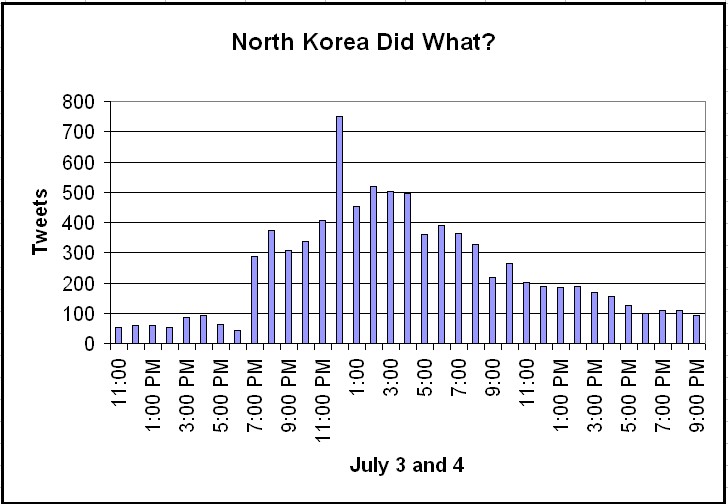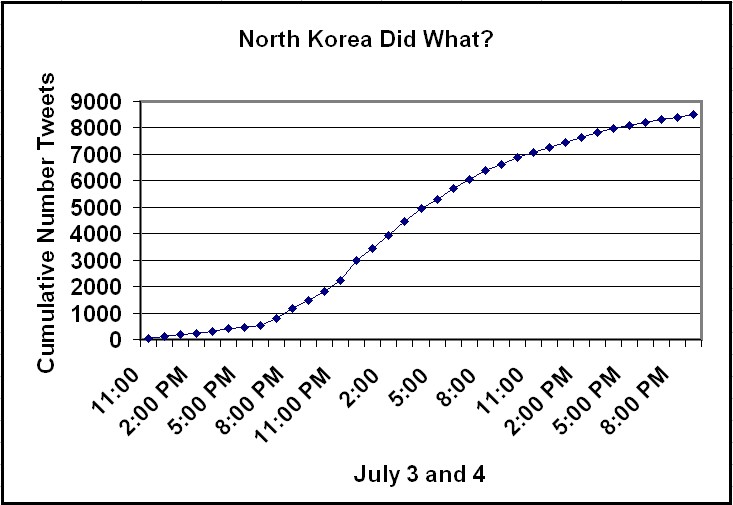
North Korea Did What?
The Dynamics of Attention
G. R. Boynton
On July 3 North Korea started shooting missiles in the general direction of Japan, and their launchings continued throughout July 4. Since they did not announce their intentions most observers have interpreted it as an act of 'thumbing its nose' at the U.S. At least that was the interpretation of The Washington Post.
TOKYO, July 4 -- Taunting the United States on its birthday, North Korea fired seven missiles into the Sea of Japan early Saturday in a provocative move . . . [Blaine Harden and Joby Warrick, Washington Post July 4, 2009.]
The Washington Post was a bit late to the story, however. The missile launchings had already been the subject of thousands of posts on the web before it made The Post in the July 4 edition. This is an examination of the dynamics of posting comments to Twitter about North Korea, and here is one of the very early tweets.
7/3/2009 11:57 a.m. Why is it that MJ's death is still on the front page of CNN when North Korea just launched a bunch of fucking missiles?
Twitter sets a limit of 140 characters on each message posted so tweets are usually a single thought as is this one. Not only did North Korea have to share news media attention with Michael Jackson, they also had to share with Sarah Palin, who announced that she would resign as governor of Alaska Friday, July 3, at 4:00 p.m. The Washington Post produced a "Breaking News" for her announcement, but not for the North Korean actions.
The software I used to capture tweets about North Korea accessed the Twitter API every 10 minutes updating the data file. Tweets posted between 11:00 a.m. July 3 and 10:00 p.m. July 4 are used for the analysis. A total of 8508 tweets were posted during the 34 hours covered, which is an average of 250 tweets an hour.
There are two interesting points revealed in this brief analysis. First, the web never sleeps. The following table shows the number of tweets per hour for the period.
 |
The tweets began between 11:00 and 12:00 a.m. on July 3. The number is under one hundred per hour until 7:00 p.m. when the number of tweets takes a big jump to just under 300. The greatest number of tweets per hour was midnight to 1:00 a.m. with more than 700 tweets. Then there were about 450 between 1:00 and 2:00 a.m., approximately 500 at 2:00, 3:00, and 4:00 a.m. Then the number of tweets per hour slowly declined until it was back to approximately 100 per hour by the evening of July 4. So, who was tweeting at 3:00 a.m. my time, which is U.S. central daylight savings. Well, Twitter is a worldwide communication system. The number of unique users of Twitter in May 2009 was, by one count, 37 million, and the number grows at a remarkably fast clip. It is still growing more than one thousand percent year to year each month. Unfortunately, the geographic location of the tweeters is not available for this analysis. But if timing is any indication they are piling in from all over the world. The web never sleeps.
The second point begins by looking at the numbers in a different way. The figure below gives the cumulative number of tweets for each hour during the period.
 |
This is the S shaped sigmoid curve that is often associated with 'going viral.' It works like an epidemic: a few people write about the subject, a larger number read and then write, a larger number read and then write until a limit is reached in terms of the interest in the subject. Retweeting, which is reading and then writing referring to what one read, is quite popular on Twitter. Retweeting is the Twitter mechanism for going viral. 'Going viral' on the web has generally been associated with YouTube and viewing videos. Crane and Sornette (2008) examined 5 million time series of viewing YouTube videos to characterize their dynamics. They found that a tiny fraction, two percent or less, could be interpreted in terms of a sigmoid curve. In my research on viewing the videos the McCain and Obama campaigns posted to YouTube I found not a single video for which the daily views took this functional form. (Boynton, 2009). This is a different dynamics of attention than found in the YouTube campaigns, and that implies different underlying social processes at work. Of course, this is a single case compared with the hundreds of campaign videos.
What do we know and not know? We know that Twitter is an important communication activity. My favorite way of thinking about its importance is that in April of 2009 the number of unique users of Twitter exceeded the unique visitors to The New York Times and to The Wall Street Journal (Marshall Kirkpatrick, May 11, 2009). It is now a more frequently used institution of 'news' than either of what we think of as very important news institutions. However, it has been important only very briefly. A year ago the unique users per month was in the hundreds of thousands. There has been some research, beyond counting unique users, but I do not know of any studies of Twitter and politics. I assume there is something I have not found, but there has to be very little research to this point.
We do not know what is big and what is small. We know quite a lot about relative sizes for political videos on YouTube. We know the average number of views of the McCain campaign videos was about 168,000 compared with 53,000 for the Obama campaign videos (Boynton, 2009). Nine thousand does not seem to be a very big number relative to those. However, tweets are 'comments' you write. The average number of comments written about a McCain video was about 2700. For Obama campaign videos the average number of comments was 75. Nine thousand 'comments' about the North Korean missile launching looks impressive by that standard.
We know almost nothing about the subjects that will inspire people to comment. I have also been counting tweets about Sarah Palin's resignation. As of 12:53 a.m. July 6, 2009 there have been 10,000 tweets about North Korea and 49,000 about Sara Palin.
We know nothing about the social process. There may be a lot of 'going viral' in tweeting. It is easy to do by retweeting. There was too little to show up in the 2008 YouTube campaigns. Twitter may be a different social process than viewing campaign videos.
We have only a very general notion about how international Twitter is. It is international, but we know nothing about how that works in terms of subjects about which people are tweeting. Tweeting at my 3:00 a.m. surely requires a different time zone in which one lives.
There is a lot to learn.
Citations:
G. R. Boynton (2009) The web version of this piece.
G. R. Boynton (2009) The YouTube Campaign: The 2008 Presidential Election, Peter Lang, Inc.
R. Craine and D. Sornette (2008) Robust dynamic classes revealed by measuring the response function of a social system, http://www.pnas.org/content/104=5/41/15649.short.
Blaine Harden and Joby Warrick (July 5, 2009) North Korea Launches 5 Missiles Off Its East Coast, The Washington Post
Marshall Kirkpatrick (May 11, 2009)Twitter Passes NYT and WST in Unique Visitors, ReadWriteWeb